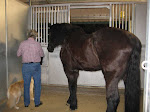Yesterday I had several discussions involving the rescue, rehabilitation, and recognizing of signals concerning various animals.
The series of discussions began because I was telling various friends and acquaintances about an upcoming event where Pat Parelli and Cesar Millan are going to do some work together. I am really interested in this because I am an admirer of their work.
I hope Cesar takes some pages from Pat’s book and organizes his knowledge in more accessible forms for others to learn from. The greatest contribution to the horse world the Parellis have made in my opinion is that they have taken what they know and broken it down into tiny bits so others can use this knowledge to have positive results with their own horses even if they don’t have direct access to Pat or Linda. They also organized a training program so that now, regardless of what part of the country you are in you can find a professional who knows how to use these methods to help you and your horse.
All that being said I’m going to put in my two cents worth about the term whisperer. It is bandied about a lot since a certain book appeared a decade or so ago. The problem with the word or term if you will is that it implies the person has some special secret language that he or she speaks to animals with. In a way this is true.
The real secret though about “whisperering” isn’t that the trainer or tamer is speaking, but rather that she is listening. Listening to what the animal is saying. Most people don’t realize that even humans have a rich vocabulary when it comes to body language. Animals have an incredibly huge vocabulary.
People who are really good at various occupations that involve dealing with large numbers of people know this and use it to improve their success. Successful animal trainers learn to “read” not only the animals they train, but the people involved with those animals.
In my persona as the Lazy Trainer I’ve been reviewing my “whispering” skills with my horses, cats and dogs; trying to analyze those skills so I can tell others exactly how to acquire them and effectively use them.
The first and most important key to being successful is the ability accurately read an animal’s body language. One time I was called in to work with an extremely “aggressive” gelding. He would attack anyone trying to enter his pen or even if they got near it. His owner, trainer and the stable manager all said he was a very dominant horse that wanted to be in control of everyone and everything.
When I got my first view of the horse my reading was he was a horse scared out of his wits. Everything he was doing was in an effort to save his life. Using calm, assertive lead mare body language I approached his pen. Instead of charging the fence he paused, looked at me for a moment, and then retreated to the far side of the pen.
I took my carrot stick with me because, even if he was thinking about the idea I might be a lead mare, that did not mean he wouldn’t try something dangerous. I prefer not to be run over by large (or even small) horses if I can help it. I entered the pen and went to the center. From there I carefully looked all around paying close attention to everything a horse might consider dangerous. When I completed my survey I then turned partially sideways to the horse where I could see him from the corner of my eye and assumed the position of a horse completely comfortable in its surroundings. I dropped the tip of the carrot stick (representing a long neck) to the ground and then “cocked” one hind leg.
The horse watched me for several minutes before taking his first cautious step towards me. However, he told me by his eyes, ears, nostrils, head position, neck position, leg position and body position that he was beginning to accept the idea that I might be “safe.” When he took that first step I gave him a lead mare look that said, “You better be respectful or I’m going to kick you!” He immediately dipped his head in a respectful nod. It took several minutes but eventually he was standing near me. Then I turned and walked back to the gate. He followed with properly lowered head. He had no desire to be in control. That horse really, really wanted to have a leader he could feel safe with.
It took quite awhile and a number of setbacks, but eventually I did get his owner to understand how her body language and the body language of other humans around him had caused this horse to reach such a high state of anxiety. The people who managed the place and the trainer were less willing to learn, so eventually she moved to a stable where the people spoke “horse” and he became a nice willing companion to her.
Being able to read body language fluently means you can stop bad behavior before it even gets to movement. If you wait until movement is involved then you have to work a LOT harder to correct it and that is against the Lazy Trainer’s Creed.
Lazy Trainer Tip
Learn to read your animals’ body language. Learn how to speak to them in body language and you will be on your way to being considered a “whisperer” even though being an animal whisperer has nothing to do with vocal language.
Saturday, June 28, 2008
Subscribe to:
Post Comments (Atom)










No comments:
Post a Comment